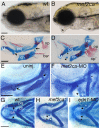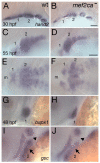mef2ca is required in cranial neural crest to effect Endothelin1 signaling in zebrafish
- PMID: 17574232
- PMCID: PMC2148033
- DOI: 10.1016/j.ydbio.2007.05.018
mef2ca is required in cranial neural crest to effect Endothelin1 signaling in zebrafish
Abstract
Mef2 genes encode highly conserved transcription factors involved in somitic and cardiac mesoderm development in diverse bilaterians. Vertebrates have multiple mef2 genes. In mice, mef2c is required for heart and vascular development. We show that a zebrafish mef2c gene (mef2ca) is required in cranial neural crest (CNC) for proper head skeletal patterning. mef2ca mutants have head skeletal phenotypes resembling those seen upon partial loss-of-function of endothelin1 (edn1). Furthermore, mef2ca interacts genetically with edn1, arguing that mef2ca functions within the edn1 pathway. mef2ca is expressed in CNC and this expression does not require edn1 signaling. Mosaic analyses reveal that mef2ca is required in CNC for pharyngeal skeletal morphogenesis. Proper expression of many edn1-dependent target genes including hand2, bapx1, and gsc, depends upon mef2ca function. mef2ca plays a critical role in establishing the proper nested expression patterns of dlx genes. dlx5a and dlx6a, known Edn1 targets, are downregulated in mef2ca mutant pharyngeal arch CNC. Surprisingly, dlx4b and dlx3b are oppositely affected in mef2ca mutants. dlx4b expression is abolished while the edn1-dependent dlx3b is ectopically expressed in more dorsal CNC. Together our results support a model in which CNC cells require mef2ca downstream of edn1 signaling for proper craniofacial development.
Figures









Similar articles
-
phospholipase C, beta 3 is required for Endothelin1 regulation of pharyngeal arch patterning in zebrafish.Dev Biol. 2007 Apr 1;304(1):194-207. doi: 10.1016/j.ydbio.2006.12.027. Epub 2006 Dec 19. Dev Biol. 2007. PMID: 17239364 Free PMC article.
-
edn1 and hand2 Interact in early regulation of pharyngeal arch outgrowth during zebrafish development.PLoS One. 2013 Jun 24;8(6):e67522. doi: 10.1371/journal.pone.0067522. Print 2013. PLoS One. 2013. PMID: 23826316 Free PMC article.
-
Requirements for Endothelin type-A receptors and Endothelin-1 signaling in the facial ectoderm for the patterning of skeletogenic neural crest cells in zebrafish.Development. 2007 Jan;134(2):335-45. doi: 10.1242/dev.02704. Epub 2006 Dec 13. Development. 2007. PMID: 17166927
-
Regulation of facial morphogenesis by endothelin signaling: insights from mice and fish.Am J Med Genet A. 2010 Dec;152A(12):2962-73. doi: 10.1002/ajmg.a.33568. Am J Med Genet A. 2010. PMID: 20684004 Free PMC article. Review.
-
Understanding endothelin-1 function during craniofacial development in the mouse and zebrafish.Birth Defects Res C Embryo Today. 2004 Jun;72(2):190-9. doi: 10.1002/bdrc.20007. Birth Defects Res C Embryo Today. 2004. PMID: 15269892 Review.
Cited by
-
Conserved and unique transcriptional features of pharyngeal arches in the skate (Leucoraja erinacea) and evolution of the jaw.Mol Biol Evol. 2021 Sep 27;38(10):4187-4204. doi: 10.1093/molbev/msab123. Mol Biol Evol. 2021. PMID: 33905525 Free PMC article.
-
New perspectives on pharyngeal dorsoventral patterning in development and evolution of the vertebrate jaw.Dev Biol. 2012 Nov 15;371(2):121-35. doi: 10.1016/j.ydbio.2012.08.026. Epub 2012 Aug 30. Dev Biol. 2012. PMID: 22960284 Free PMC article. Review.
-
Selective breeding modifies mef2ca mutant incomplete penetrance by tuning the opposing Notch pathway.PLoS Genet. 2019 Dec 2;15(12):e1008507. doi: 10.1371/journal.pgen.1008507. eCollection 2019 Dec. PLoS Genet. 2019. PMID: 31790396 Free PMC article.
-
Developmental processes regulate craniofacial variation in disease and evolution.Genesis. 2019 Jan;57(1):e23249. doi: 10.1002/dvg.23249. Epub 2018 Oct 1. Genesis. 2019. PMID: 30207415 Free PMC article. Review.
-
Dlx genes pattern mammalian jaw primordium by regulating both lower jaw-specific and upper jaw-specific genetic programs.Development. 2008 Sep;135(17):2905-16. doi: 10.1242/dev.019778. Development. 2008. PMID: 18697905 Free PMC article.
References
-
- Angelo S, et al. Conservation of sequence and expression of Xenopus and zebrafish dHAND during cardiac, branchial arch and lateral mesoderm development. Mech Dev. 2000;95:231–7. - PubMed
-
- Bi W, et al. The transcription factor MEF2C-null mouse exhibits complex vascular malformations and reduced cardiac expression of angiopoietin 1 and VEGF. Dev Biol. 1999;211:255–67. - PubMed
-
- Black BL, Olson EN. Transcriptional control of muscle development by myocyte enhancer factor-2 (MEF2) proteins. Annu Rev Cell Dev Biol. 1998;14:167–96. - PubMed
Publication types
MeSH terms
Substances
Grants and funding
LinkOut - more resources
Full Text Sources
Molecular Biology Databases
Research Materials

